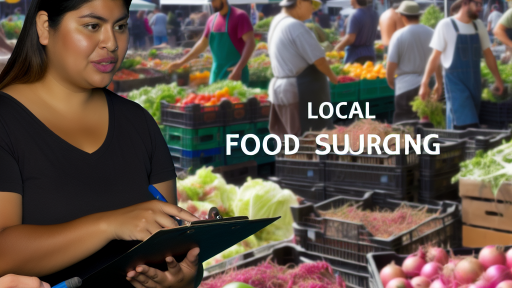Introduction to Seasonal Eating and Its Relevance to Sustainable Farming
Seasonal eating emphasizes consuming foods that are in season.
This practice aligns our diets with the natural growing cycles.
Consequently, it encourages the consumption of fresh and local produce.
Seasonal eating reduces the carbon footprint associated with food transportation.
It often supports local farmers, promoting community connections.
Enhancing Sustainability Through Local Sourcing
Eating seasonally means sourcing food from nearby farms.
This practice stimulates local economies and strengthens communities.
Moreover, it reduces dependency on industrial agriculture.
By supporting local farmers, we enhance biodiversity in agriculture.
Local sourcing encourages farmers to grow a variety of crops.
Improving Nutritional Value and Flavor
Fruits and vegetables picked in season are generally fresher.
Fresh produce is often more nutritious compared to out-of-season options.
Additionally, seasonal foods tend to offer superior flavor.
Thus, seasonal eating enhances meal enjoyment and satisfaction.
Reducing Food Waste
Seasonal eating promotes the use of crops at their peak availability.
Transform Your Agribusiness
Unlock your farm's potential with expert advice tailored to your needs. Get actionable steps that drive real results.
Get StartedThis reduces the likelihood of food waste across the supply chain.
Furthermore, it encourages cooking with what is currently available.
Consequently, it fosters creativity in meal preparation.
Engaging with Nature and Food Systems
Seasonal eating deepens our connection to food systems.
It increases awareness of seasonal changes in the environment.
This engagement fosters appreciation for agricultural processes.
Additionally, it builds a sense of community around shared food practices.
Nutritional Benefits of Consuming Seasonal Produce
Enhanced Nutrient Intake
Eating seasonal produce boosts nutrient intake significantly.
Fruits and vegetables grown in their natural season are often richer in vitamins.
They contain higher levels of antioxidants, which promote overall health.
Additionally, seasonal foods are harvested at their peak ripeness.
This heightens their flavor and color, making them more appealing.
Improved Digestibility
Seasonal foods tend to be easier to digest for many individuals.
This is largely due to their freshness and natural growing cycles.
Moreover, your body adapts to process these foods more efficiently.
Eating locally encourages a variety of foods in your diet.
This variety aids in maintaining intestinal health.
Supports Metabolic Health
Seasonal eating aligns with the body’s natural metabolic rhythms.
This helps regulate digestion and energy levels throughout the year.
For instance, warming foods in winter can boost metabolism.
Conversely, light and refreshing foods in summer aid hydration.
Reduction of Food Additives and Preservatives
Consuming seasonal produce often means fewer additives.
These items are usually sold fresh and aren’t transported long distances.
As a result, they require less packaging and fewer preservatives.
Showcase Your Farming Business
Publish your professional farming services profile on our blog for a one-time fee of $200 and reach a dedicated audience of farmers and agribusiness owners.
Publish Your ProfileThis leads to healthier meal options overall.
Cost-Effectiveness
Buying seasonal produce is often more economical.
Local farmers can price their goods competitively when in season.
Moreover, lower transportation costs translate into savings for consumers.
Choosing seasonal items can help stretch your grocery budget further.
Economic Advantages for Local Farmers Promoting Seasonal Crops
Encouraging Local Commerce
Seasonal eating strengthens local economies by boosting sales for farmers.
When consumers prioritize seasonal products, they support nearby farmers.
This practice creates a reliable income stream for local agricultural businesses.
Additionally, it reduces transportation costs, benefiting both producers and consumers.
Enhancing Crop Diversity
Emphasizing seasonal crops encourages farmers to diversify their offerings.
Diverse planting reduces risks associated with pests and diseases.
This diversity also attracts customers looking for unique, fresh options.
Reducing Environmental Impact
Promoting seasonal crops lessens the carbon footprint of food production.
Shorter supply chains mean fewer emissions from transportation.
Moreover, seasonal farming practices often use less chemical input.
This contributes to healthier soil and improved land sustainability.
Strengthening Community Relationships
Seasonal eating fosters connections between consumers and local farmers.
Farmers’ markets provide opportunities for direct sales.
These interactions build trust and loyalty within the community.
Consequently, locals feel more invested in supporting their farmers.
Supporting Local Food Systems
Seasonal eating aligns with local food systems and sustainability efforts.
This approach enhances food security by making fresh produce available.
Furthermore, it encourages the consumption of fruits and vegetables in season.
Ultimately, this promotes healthier eating habits within the community.
See Related Content: Financial Benefits of Starting Agri-Tourism on Your Farm
Impact of Seasonal Eating on Reducing Carbon Footprint
Understanding Seasonal Eating
Seasonal eating involves choosing foods at their peak ripeness.
Additionally, it encourages consumption of local produce.
This practice directly connects consumers to local farms.
Furthermore, it aligns food choices with the growing seasons.
Reduction of Transportation Emissions
Eating seasonally minimizes the need for long-distance transportation.
When food travels less distance, it leads to a decrease in carbon emissions.
Locally sourced products typically require less fuel for transportation.
This significantly contributes to lowering greenhouse gas output.
Support for Local Farmers
By choosing seasonal foods, consumers directly support local farmers.
This boosts local economies and promotes sustainable agriculture.
Moreover, it helps in reducing the environmental impact of farming practices.
Enhancing Biodiversity
Seasonal eating encourages a diverse range of crops to be grown.
This practice supports various species and improves soil health.
In turn, it enhances the resilience of ecosystems against climate change.
Moreover, diverse crops reduce the risk of pests and diseases.
Showcase Your Farming Business
Publish your professional farming services profile on our blog for a one-time fee of $200 and reach a dedicated audience of farmers and agribusiness owners.
Publish Your ProfileImproving Nutritional Value
Fresh, seasonal foods often have higher nutritional content.
Eating foods in season ensures optimal freshness and taste.
Additionally, it enhances the flavor profiles of meals.
Consequently, consuming seasonal produce can lead to healthier eating habits.
Explore Further: Understanding Local Food Supply Chains for Farmers
Enhancement of Soil Health Through Crop Rotation and Seasonal Planting
Understanding Crop Rotation
Crop rotation involves alternating different crops in the same area across seasons.
This practice improves soil structure and fertility.
Moreover, it helps break cycles of pests and diseases.
As plants from different families have varying nutrient requirements, this prevents soil depletion.
Additionally, crop rotation encourages a diverse ecosystem.
Benefits of Seasonal Planting
Seasonal planting aligns crops with their ideal growing conditions.
This maximizes yield and minimizes resource waste.
Planting according to the season also promotes natural pest control.
For example, summer crops like tomatoes thrive in warm weather.
Conversely, leafy greens flourish in cooler temperatures.
Impact on Soil Microbiology
Crop rotation enhances beneficial soil microbes.
Different crops provide various organic matter types for these microbes.
This diversity improves nutrient cycling and soil health.
Thus, healthy soil supports robust plant growth.
Water Retention and Erosion Control
Crop rotation and seasonal planting contribute to better water retention.
Diverse root systems create channels for water infiltration.
Consequently, this reduces runoff and soil erosion.
Healthy soil holds more moisture and nutrients for plants.
Long-term Sustainability
Implementing crop rotation and seasonal planting promotes long-term agricultural sustainability.
This strategy enhances resilience against climate variability.
Farmers benefit from reduced reliance on chemical inputs.
Healthier soil systems yield more diverse and abundant harvests.
Explore Further: How Agri-Tourism Enhances the Farm-to-Table Movement

Promoting Biodiversity and Ecosystem Resilience in Seasonal Farming
Enhancing Biodiversity
Seasonal eating positively impacts biodiversity in local ecosystems.
By consuming seasonal produce, we encourage diverse crop cultivation.
This practice reduces reliance on monocultures, which deplete soil nutrients.
Moreover, diverse cropping systems support a wide range of wildlife.
Building Ecosystem Resilience
Seasonal farming practices contribute to ecosystem resilience.
They enhance soil health through crop rotation and cover cropping.
This method improves soil structure and fertility naturally.
As a result, resilient ecosystems can better withstand climate challenges.
Supporting Local Pollinators
Seasonal eating also aids local pollinator populations.
Native plants bloom at different times throughout the seasons.
This encourages a steady food supply for pollinators like bees and butterflies.
Healthy pollinator populations increase crop yields and quality.
Showcase Your Farming Business
Publish your professional farming services profile on our blog for a one-time fee of $200 and reach a dedicated audience of farmers and agribusiness owners.
Publish Your ProfileMinimizing Environmental Impact
Reducing transportation for food lowers carbon emissions.
Seasonal eating promotes the consumption of locally sourced products.
It decreases the energy required for long-distance food distribution.
This approach fosters more sustainable agricultural practices.
Strengthening Community Connections
Seasonal farming builds stronger community ties.
Farmers’ markets showcase local produce and support small-scale farmers.
Consumers engage with farmers and learn about their practices.
This connection encourages a shared commitment to sustainability.
Explore Further: Embracing Seasonal Produce in Farm-to-Table Systems
Community Engagement and Education in Seasonal Eating Practices
Building Awareness
Community engagement starts with awareness of seasonal eating.
Educating the public about local food sources is crucial.
Workshops can introduce residents to local produce availability.
Social media campaigns can spread the message quickly.
Local farmers’ markets offer excellent opportunities for education.
Promoting Farmer Education
It is essential to educate farmers about the benefits of seasonal practices.
Crops should be tailored to seasonal cycles for optimal yield.
Farmers can learn from each other through cooperative programs.
Organizations like Green Fields Initiative support sustainable farming education.
Engaging Local Schools
Schools play a vital role in promoting seasonal eating.
Programs can connect students with local agriculture through hands-on learning.
Garden projects in schools teach children about food sources.
Field trips to farms can enhance their understanding of agriculture.
Creating Community Events
Seasonal food festivals can celebrate local produce.
Such events promote community bonding and highlight food education.
Cooking demonstrations can teach participants how to use local ingredients.
Collaborating with chefs can enhance these experiences significantly.
Encouraging Local Businesses
Local restaurants can support seasonal eating by featuring local dishes.
Special menus can reflect seasonal harvests, attracting more customers.
Partnerships with farms can ensure reserved supply chains.
This encourages responsible sourcing and supports local economies.
Challenges and Solutions in Adopting a Seasonal Eating Lifestyle
Understanding Seasonal Availability
Seasonal eating requires knowledge of what fruits and vegetables are in season.
Many people struggle to identify seasonal produce.
This lack of awareness can lead to frustration when shopping.
Learning about local agriculture can bridge this gap.
Using apps or guides can help consumers stay informed.
Shopping Habits and Accessibility
One challenge is finding seasonal items consistently.
Local farmers’ markets may offer limited hours or locations.
Additionally, not everyone lives near a market.
Joining a community-supported agriculture (CSA) program can be a solution.
This approach provides regular access to seasonal produce.
Showcase Your Farming Business
Publish your professional farming services profile on our blog for a one-time fee of $200 and reach a dedicated audience of farmers and agribusiness owners.
Publish Your ProfileMoreover, online farmers’ markets are becoming more popular.
Meal Planning and Preparation
Meal planning can feel daunting when switching to seasonal eating.
Adopting new recipes that highlight seasonal ingredients is essential.
Many people find it hard to break away from routine meals.
Creating a seasonal recipe binder can inspire freshness.
Finding seasonal meal prep resources online simplifies this process.
Cultural and Economic Considerations
Some might perceive seasonal eating as costly.
However, it can save money by reducing reliance on out-of-season imports.
Supporting local farmers boosts the local economy.
Additionally, seasonal eating can connect individuals to cultural traditions.
Exploring ethnic cuisines can introduce new seasonal ingredients.
Building Community Around Seasonal Eating
Isolation can occur when adopting a new eating lifestyle.
Joining community efforts can facilitate shared learning.
Participating in potlucks can foster a sense of belonging.
Furthermore, social media groups can provide support and ideas.
Engaging with others enhances motivation and enjoyment.




